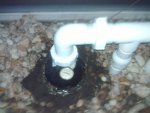duraleigh said:
Evaporative loss is normally greatest when the temperature/dewpoint spread is the widest.....mid-afternoon on a normal, clear day. Wind (mixing of the atmosphere) is a significant contributor.
The "steam" you see (usually at night and early AM) is actually condensation. The air temp just slightly above the pool water warms a little and is able to accept more water vapor (gaseous). As that tiny layer of warmer air rises, it is quickly cooled by the surrounding atmosphere and becomes totally saturated....producing condensation (wherein the water vapor returns to it's liquid state).
You do not see the "steam" (condensation) in the daytime because the surrounding atmosphere has a wider temp/dewpoint spread and can accept far more water in it's gaseous state. The greater the temp/dewpoint spread, the more evaporative loss occurs. Those of you living in the desert Soutwest in that low relative humidity can attest to that.
Your explanation sounds real "official/technical" to me, but condensation means my pool level should rise-which in fact it does not-just the opposite. But my solar cover comes off every day at 1200 and back on at 1800. The only time my water level goes down is when I do not install my solar cover at night. I also run my pool pump ONLY during the day. With these facts in mind, how do we explain the NO decrease in water loss (almost 0) when my solar cover is on at night??? Just the other day, I was too lazy to install my solar cover, and it dipped down to 54F (my pump was off), and wa, la, I lost almost a half inch in water level. There was no loss in water level during that same day (it got up to 80F)(the pool was at 88F since I have a heater).


